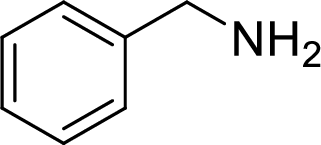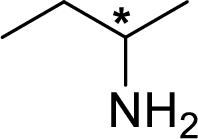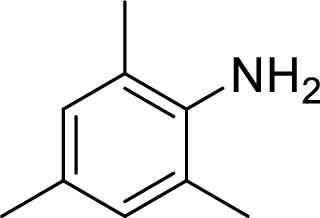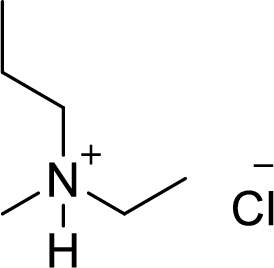
(a)
Interpretation:
Structural formula has to be drawn for a secondary arylamine with molecular formula
Concept introduction:
In chemistry Structure is the arrangement of
Depending on the number of carbon side chain of the amide, different types of amides can form.

If nitrogen atom of amine group is attached only to alkyl groups, then it is an aliphatic amine.
If nitrogen atom of amine group is attached to at least one aryl groups, then it is an
If nitrogen atom of amine group is a part of an aromatic ring, then it is a heterocyclic aromatic amine.
If nitrogen atom of amine group is a part of a ring, then it is a heterocyclic amine.
(a)
Explanation of Solution
Given molecular formula is
The compound is secondary amine so the nitrogen of amine group should be bonded with two carbon containing groups. Also this nitrogen atom must attach to an aryl group.
Therefore,
Structural formula of a secondary arylamine with molecular formula

(b)
Interpretation:
Structural formula has to be drawn for a tertiary arylamine with molecular formula
Concept introduction:
In chemistry Structure is the arrangement of chemical bonds between atoms in a molecule, specifically which atoms are chemically bonded to what other atoms with what kind of chemical bond.
Amines are the derivatives of ammonia
Depending on the number of carbon side chain of the amide, different types of amides can form.

If nitrogen atom of amine group is attached only to alkyl groups, then it is an aliphatic amine.
If nitrogen atom of amine group is attached to at least one aryl groups, then it is an aromatic amine.
If nitrogen atom of amine group is a part of an aromatic ring, then it is a heterocyclic aromatic amine.
If nitrogen atom of amine group is a part of a ring, then it is a heterocyclic amine.
(b)
Explanation of Solution
Given molecular formula is
The compound is secondary amine so the nitrogen of amine group should be bonded with three carbon containing groups. Also this nitrogen atom must attach to an aryl group.
Therefore,
Structural formula of a tertiary arylamine with molecular formula

(c)
Interpretation:
Structural formula has to be drawn for a primary aliphatic amine with molecular formula
Concept introduction:
In chemistry Structure is the arrangement of chemical bonds between atoms in a molecule, specifically which atoms are chemically bonded to what other atoms with what kind of chemical bond.
Amines are the derivatives of ammonia
Depending on the number of carbon side chain of the amide, different types of amides can form.

If nitrogen atom of amine group is attached only to alkyl groups, then it is an aliphatic amine.
If nitrogen atom of amine group is attached to at least one aryl groups, then it is an aromatic amine.
If nitrogen atom of amine group is a part of an aromatic ring, then it is a heterocyclic aromatic amine.
If nitrogen atom of amine group is a part of a ring, then it is a heterocyclic amine.
(c)
Explanation of Solution
Given molecular formula is
The compound is primary amine so the nitrogen of amine group should be bonded with only one carbon containing group. Also this nitrogen atom must attach to an alkyl group.
Therefore,
Structural formula of a primary aliphatic amine with molecular formula

(d)
Interpretation:
Structural formula has to be drawn for a chiral primary amine with molecular formula
Concept introduction:
In chemistry Structure is the arrangement of chemical bonds between atoms in a molecule, specifically which atoms are chemically bonded to what other atoms with what kind of chemical bond.
Amines are the derivatives of ammonia
Depending on the number of carbon side chain of the amide, different types of amides can form.

Chiral carbon: A carbon is said to be chiral carbon if it is bonded to four different substituents.
If nitrogen atom of amine group is attached only to alkyl groups, then it is an aliphatic amine.
If nitrogen atom of amine group is attached to at least one aryl groups, then it is an aromatic amine.
If nitrogen atom of amine group is a part of an aromatic ring, then it is a heterocyclic aromatic amine.
If nitrogen atom of amine group is a part of a ring, then it is a heterocyclic amine.
(d)
Explanation of Solution
Given molecular formula is
The compound is primary amine so the nitrogen of amine group should be bonded with only one carbon containing group. Since the compound is chiral, one carbon atom should be bonded with four different groups.
Therefore,
Structural formula of a chiral primary amine with molecular formula

Chiral carbon is labelled with asterisk (*) as above.
(e)
Interpretation:
Structural formula has to be drawn for a tertiary heterocyclic amine with molecular formula
Concept introduction:
In chemistry Structure is the arrangement of chemical bonds between atoms in a molecule, specifically which atoms are chemically bonded to what other atoms with what kind of chemical bond.
Amines are the derivatives of ammonia
Depending on the number of carbon side chain of the amide, different types of amides can form.

If nitrogen atom of amine group is attached only to alkyl groups, then it is an aliphatic amine.
If nitrogen atom of amine group is attached to at least one aryl groups, then it is an aromatic amine.
If nitrogen atom of amine group is a part of an aromatic ring, then it is a heterocyclic aromatic amine.
If nitrogen atom of amine group is a part of a ring, then it is a heterocyclic amine.
(e)
Explanation of Solution
Given molecular formula is
The compound is secondary amine so the nitrogen of amine group should be bonded with three carbon containing groups. Also this nitrogen atom must be one of the atoms of the ring since the compound is a heterocyclic amine.
Therefore,
Structural formula of a tertiary heterocyclic amine with molecular formula

(f)
Interpretation:
Structural formula has to be drawn for a trisubstituted primary arylamine with molecular formula
Concept introduction:
In chemistry Structure is the arrangement of chemical bonds between atoms in a molecule, specifically which atoms are chemically bonded to what other atoms with what kind of chemical bond.
Amines are the derivatives of ammonia
Depending on the number of carbon side chain of the amide, different types of amides can form.

If nitrogen atom of amine group is attached only to alkyl groups, then it is an aliphatic amine.
If nitrogen atom of amine group is attached to at least one aryl groups, then it is an aromatic amine.
If nitrogen atom of amine group is a part of an aromatic ring, then it is a heterocyclic aromatic amine.
If nitrogen atom of amine group is a part of a ring, then it is a heterocyclic amine.
(f)
Explanation of Solution
Given molecular formula is
The compound is primary amine so the nitrogen of amine group should be bonded with only one carbon containing group. Also this nitrogen atom must attach to an aryl group that has three substituents.
Therefore,
Structural formula of a trisubstituted primary arylamine with molecular formula

(g)
Interpretation:
Structural formula has to be drawn for a chiral quaternary ammonium salt with molecular formula
Concept introduction:
In chemistry Structure is the arrangement of chemical bonds between atoms in a molecule, specifically which atoms are chemically bonded to what other atoms with what kind of chemical bond.
Amines are the derivatives of ammonia
Depending on the number of carbon side chain of the amide, different types of amides can form.

Chirality: It refers to an atom in a molecule that contains four different substituents.
If nitrogen atom in amine group is attached with four atoms or group of atoms then the compound can be named as the salt of the corresponding amine (quaternary ammonium salt).
(g)
Explanation of Solution
Given molecular formula is
The compound is quaternary ammonium salt so the nitrogen of amine group should be bonded with group of atoms. Since the compound is chiral, the four groups attached to this nitrogen should be different.
Therefore,
Structural formula of a chiral quaternary ammonium salt with molecular formula

Chiral atom is labelled with asterisk (*) as above.
Want to see more full solutions like this?
Chapter 23 Solutions
Organic Chemistry
- What is the missing intermediate 1 and the final product 2. Please include a detailed explanation explaining the steps of malonic ester synthesis. Please include drawings of the intermediate and how it occurs and how the final product is former.arrow_forwardWhat would be the reagents and conditions above and below the arrow that will complete the proposed acetoacetic ester synthesis? If it cannot be done efficiently, then I will choose that answer. There could be 2 or 4 reagents involved. Please provide a detailed explanation and drawings showing how it would proceed with the correct reagents.arrow_forwardFor benzene, the ∆H° of vaporization is 30.72 kJ/mol and the ∆S° of vaporization is 86.97 J/mol・K. At 1.00 atm and 228.0 K, what is the ∆G° of vaporization for benzene, in kJ/mol?arrow_forward
- The reaction Q(g) + R(g) → Z(l) is shown to be exothermic. Which of the following is true concerning the reaction. it is spontaneous only at High T, it is spontaneous at low T it is nonspontaneous at all T it is spontanrous at all T. it is non spontaneous only at low T.arrow_forwardThe reaction Q(g) + R(g) → Z(l) is shown to be exothermic. Which of the following is true concerning the reactionarrow_forwardWhich of the following has the largest standard molar entropy, S° (298.15 K) He H2 NaCl KBr Hgarrow_forward
- Which of the following is true for a particular reaction if ∆G° is -40.0 kJ/mol at 290 K and –20.0 kJ/mol at 390 K?arrow_forwardWhat is the major product of the following reaction? O O OH OH 1. BH 2. H₂O₂, NaOH OH OHarrow_forwardDraw the products formed when each ester is hydrolyzed with water and sulfuric acid.arrow_forward
 Organic ChemistryChemistryISBN:9781305580350Author:William H. Brown, Brent L. Iverson, Eric Anslyn, Christopher S. FootePublisher:Cengage Learning
Organic ChemistryChemistryISBN:9781305580350Author:William H. Brown, Brent L. Iverson, Eric Anslyn, Christopher S. FootePublisher:Cengage Learning Introductory Chemistry: An Active Learning Approa...ChemistryISBN:9781305079250Author:Mark S. Cracolice, Ed PetersPublisher:Cengage Learning
Introductory Chemistry: An Active Learning Approa...ChemistryISBN:9781305079250Author:Mark S. Cracolice, Ed PetersPublisher:Cengage Learning

